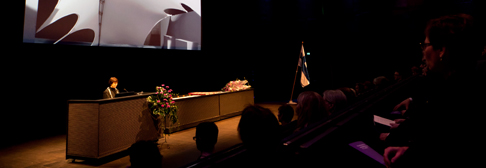Distinguished professionals honoured at the first anniversary gala of the School of Arts, Design and Architecture
11.01.2012
The School of Arts, Design and Architecture started its first year with an anniversary gala where for the first time representatives of the design sectors were joined by architectural professionals.
The anniversary gala continues the festive traditions of the former School of Art and Design as part of which distinguished and successful professionals are honoured for their work and new professors give their opening lectures.
Mika Ripatti is 2012 Alumnus of the Year
Each year, the School of Arts, Design and Architecture selects an alumnus of the year in recognition of pioneering or outstanding work in the field of design and architecture.
This year the award went to animator Mika Ripatti, a graduate of the Degree Programme in Graphic Design. Already during his student days, Ripatti was a pioneer in computer animation and later taught the subject in the Media Laboratory. He also worked on the development of the brand of the Nelonen Media television company in which he was able to make use of advanced and extremely sophisticated animation graphics. In the year 2000, Mika Ripatti managed to get a job at Blue Sky Studios in New York where the production of the film “Ice Age” was about to start.
Since then Mika Ripatti has become one of Hollywood’s top animators and millions of viewers around the world have been able to enjoy his graphics in a large number of successful films and other programmes. Mika Ripatti’s career is a fine example of an international success story and the School hopes that its students will emulate him, using their talent and the skills that they have developed in a creative academic environment.
Five new honorary members
Personalities who have actively supported the School of Arts, Design and Architecture or distinguished themselves in the fields it represents and other cultural activities are invited as honorary members of the School each year. At this year’s anniversary gala, five persons were bestowed with an honorary membership.
Elena Kolovskaya, director of the Pro Arte foundation based in St. Petersburg, has been actively working in a number of fields to strengthen cooperation between education and research in arts and design in Russia and to make them more internationally oriented. She has been instrumental in developing cooperation between the School of Arts, Design and Architecture and the Saint Petersburg State University, one of the top universities of Russia. At the same time, she has established a successful partnership with Cumulus International Association of Universities and Colleges of Art, Design and Media, in which the School of Arts, Design and Architecture acts as a coordinator.
Industrial designer Jussi Ahola worked as a professor of industrial design at the School of Art and Design in 1987-1993 and has also taught in a number of other design institutions in Finland and other countries. Jussi Ahola’s career as a teacher of an analytical and research-based design approach and his pioneering efforts to make design research a reality formed a basis for design research that is now, two decades later, recognised by Aalto University. Ahola wrote the first Finnish-language textbook on industrial design, which was published in 1980, and he has also received wide recognition for the functional design that his design office has produced since 1986.
Kari Moilanen, Architect SAFA, has played a central role in Finnish architecture and urban planning as the Head of Espoo City Planning. During his tenure, Espoo City Planning has developed into an ambitious and dynamic institution. Kari Moilanen has played a central role as an organiser and jury member in a number of important and groundbreaking architectural competitions. Under his guidance, the area around Otaniemi is in the process of developing into an amazing combination of technology, gardens and services. Kari Moilanen is a visionary in a post where one is expected to take creative risks so that the world can be changed in the spirit of Aalto University.
Workshop master Jussi Laasasenaho started at the School of Art and Design as a caretaker in 1966 and then moved on to take up the post of workshop master. Throughout his long career, Laasasenaho worked in customer service duties. He was known as a helpful and active staff member who enjoyed the trust of all those working with him. He made an exemplary contribution to the smooth running of the day-to-day affairs of the School. Possessing a great amount of expertise and an excellent sense of humour, Laasasenaho worked as a contact person for different events and helped both students and other staff members in practical problems.
Meri-Helga Mantere, Licentiate of Arts, worked as a lecturer in art education for many years. She initiated art-based environmental education, an area of specialisation that was unique in the world and many years ahead of its time. For Mantere, an art-based approach means active embracing of nature, observations by artistic means and the attitude of non-interference: the aim is to understand nature as an entity of its own and art as an activity that does not impose its will on nature. Methods developed by Mantere are used in many countries.
Three new professors, Alastair Fuad-Luke (Emerging Design Practices), Sampsa Hyysalo (Design and Design Cooperation) and Eero Miettinen (Design and International Product Development) gave their opening lectures at the anniversary event. The decorations awarded by the President of the Republic on 6 December 2011 (the Finnish Independence Day) were also presented during the event. The recipients were: Development Manager Pekka Saarela (Knight, First Class, of the Order of the Lion of Finland), Mikko Tuori, Workshop Master at the Department of Motion Picture, Television and Production Design (First Class Medal of the White Rose of Finland with golden cross) and Timothy Persons, who has made the photography of Helsinki School known around the world (Knight of the White Rose of Finland).
Opening lecture: Alastair Fuad-Luke
Design as Consensus Dissensus Openness.pdf



